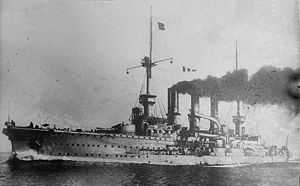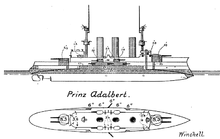SMS Prinz Adalbert (1901)
 SMS Prinz Adalbert at full speed | |
| Career (German Empire) | |
|---|---|
| Name: | Prinz Adalbert |
| Namesake: | Prince Adalbert of Prussia |
| Builder: | Kaiserliche Werft, Kiel |
| Laid down: | 1900 |
| Launched: | 22 June 1901 |
| Christened: | Princess Irene of Prussia |
| Commissioned: | 12 January 1904 |
| Fate: | Torpedoed and sunk 23 October 1915 |
| General characteristics | |
| Class and type: | Prinz Adalbert-class cruiser |
| Displacement: | 9,087 t (8,943 long tons; 10,017 short tons) normal 9,875 t (9,719 long tons; 10,885 short tons) full load |
| Length: | 126.5 m (415 ft) |
| Beam: | 19.6 m (64 ft) |
| Draught: | 7.43 m (24.4 ft) |
| Propulsion: | 16,200 hp, three shafts |
| Speed: | 20 knots (37 km/h) |
| Range: | 5,080 nmi (9,410 km; 5,850 mi) at 12 kn (22 km/h; 14 mph) |
| Complement: | 34 officers 551 enlisted men |
| Armament: | Four 21 cm (8.3 in) (2 × 2) ten 15 cm (5.9 in) (10 × 1) twelve 8.8 cm (3.5 in) (12 × 1) four 45 cm (18 in) torpedo tubes |
| Armor: | Belt: 100 mm (3.9 in) Turrets: 150 mm (5.9 in) Deck: 40 to 80 mm (1.6 to 3.1 in)[1] |
- For other ships of the same name, see SMS Prinz Adalbert
SMS Prinz Adalbert was a German armored cruiser built in the early 1900s for the Imperial German Navy, named after Prince Adalbert of Prussia (1811-1873), former Commander-in-Chief of the Prussian navy.[2] She was the lead ship of her class, which included a second ship, Friedrich Carl. Prinz Adalbert was built at the Imperial Dockyard in Kiel. She was laid down in 1900 and completed in January 1904, at the cost of 16,371,000 Marks. She was armed with a main battery of four 21 cm (8.3 in) guns and was capable of a top speed of 20 kn (37 km/h; 23 mph).
Upon commissioning, Prinz Adalbert served as a gunnery training ship, a role she held for the majority of her career. After the outbreak of World War I in August 1914, she was assigned to the reconnaissance forces in the Baltic. After her sister ship was sunk in November 1914, she became the flagship of the cruiser squadron in the Baltic. She conducted operations against Russian forces in the Baltic, including bombarding the port of Libau. She was torpedoed by a British submarine in July 1915, but was able to return to port and was repaired. She was torpedoed a second time on 23 October 1915; the torpedo detonated her ammunition magazines and destroyed the ship. She sank quickly with heavy loss of life; only three men were rescued from a crew of 675.
Construction

Prinz Adalbert was ordered under the provisional name "B" and built at the Imperial Dockyard in Kiel under construction number 27.[1][Note 1] Her keel was laid in 1900 and she was launched on 22 June 1901.[3] The launching ceremony was attended by the Kaiser, Wilhelm II, his wife Kaiserin Augusta Victoria, his brother Admiral Prince Henry of Prussia and the young sailor Prince Adalbert of Prussia. The ceremony of christening the ship was performed by Princess Irene of Prussia, wife of Prince Henry, who then delivered a speech.[2] Fitting-out work was somewhat lengthy, but was completed by 12 January 1904, being commissioned into the Imperial German Navy the same day.[3][Note 2] She had cost the Imperial German Government 16,371,000 Goldmarks.[1]
Prinz Adalbert displaced 9,087 t (8,943 long tons; 10,017 short tons) as built and 9,875 t (9,719 long tons; 10,885 short tons) fully loaded, with a length of 126.5 m (415 ft), a beam of 19.6 m (64 ft) and a draft of 7.43 m (24.4 ft) forward. She was powered by three vertical triple expansion engines, which developed a total of 17,272 indicated horsepower (12,880 kW) and yielded a maximum speed of 20.4 kn (37.8 km/h; 23.5 mph) on trials. She carried up to 1,630 t (1,600 long tons; 1,800 short tons) of coal, which enabled a maximum range of up to 5,080 nautical miles (9,410 km; 5,850 mi) at a cruising speed of 12 kn (22 km/h; 14 mph).[1]
She was armed with four 21 cm (8.3 in) guns arranged in two twin gun turrets, one on either end of the superstructure. Her secondary armament consisted of ten 15 cm (5.9 in) guns, twelve 8.8 cm (3.5 in) guns and four 45 cm (18 in) underwater torpedo tubes, one in the bow, one in the stern, and one on both beams.[1]
Service history
After commissioning and sea trials, Prinz Adalbert was placed in service as a gunnery training ship, a role she held for the majority of her career. At the outbreak of World War I in August 1914, Prinz Adalbert was brought into front-line service with the fleet.[4] After her sister ship, Friedrich Carl was sunk in November 1914,[4] Prinz Adalbert became the flagship for Admiral Behring's cruiser squadron in the Baltic Sea.[5] In January 1915, Prinz Adalbert, in company with the light cruiser Augsburg and commanded by Admiral Behring, conducted a reconnaissance sweep toward the Åland Islands. While on the return voyage, she bombarded Russian positions at Libau. She ran aground off Steinort during the operation, and Augsburg struck a mine off Bornholm.[6]
After being freed from her grounding, the ship was repaired and was ready for another operation in early May. Rear Admiral Hopman, the commander of the reconnaissance forces in the Baltic, hoisted his flag on Prinz Adalbert for a major assault on Libau, in conjunction with an attempt by the German Army to seize the city.[7] The attack took place on 7 May, and consisted of Prinz Adalbert and the armored cruisers Roon and Prinz Heinrich, the elderly coast defense ship Beowulf, and the light cruisers Augsburg, Thetis, and Lübeck. They were escorted by a number of destroyers, torpedo boats, and minesweepers. The IV Scouting Group of the High Seas Fleet was detached from the North Sea to provide cover for the operation.[8] The bombardment went as planned, though the destroyer V107 struck a mine in Libau's harbor, which blew off her bow and destroyed the ship. German ground forces were successful in their assault however, and took the city.[9]
On 1 July, the minelayer SMS Albatross, escorted by the cruisers Roon, Augsburg, and Lübeck and seven destroyers, laid a minefield north of Bogskär. While returning to port, the flotilla separated into two sections; Augsburg, Albatross, and three destroyers made for Rixhöft while the remainder of the unit went to Libau. Augsburg and Albatross were intercepted by a powerful Russian squadron commanded by Rear Admiral Bakhirev, consisting of three armored and two light cruisers.[10] Commodore Johannes von Karpf, the flotilla commander, ordered the slower Albatross to steam for neutral Swedish waters and recalled Roon and Lübeck. Albatross was grounded off Gotland and Augsburg escaped, and the Russian squadron briefly engaged Roon before both sides broke contact. Upon being informed of the situation, Hopman sortied with Prinz Adalbert and Prinz Heinrich to support von Karpf. While en route, the cruisers encountered the British submarine E9, which scored a hit on Prinz Adalbert.[11] The torpedo hit below the conning tower and caused severe damage. Prinz Adalbert took on some 2,000 t (2,000 long tons; 2,200 short tons) of water; her draft increased significantly, which prevented her from being able to put in to Danzig. She instead had to make the journey back to Kiel for repairs, which she reached on 4 July.[12]
Repairs were finally completed by October 1915. Prinz Adalbert was steaming some 20 miles west of Libau in company with a pair of destroyers on 23 October when she was intercepted by the submarine E8.[13] E8 fired a spread of torpedoes at a range of approximately 1,200 m (1,300 yd), which detonated the ship's ammunition magazine.[14] The massive explosion destroyed the ship,[13] which sank immediately with the loss of 672 crew.[4] There were only three survivors. The sinking was the greatest single loss of life for the German Baltic forces for the duration of the war.[13]
See also
- List by death toll of ships sunk by submarines
References
- Footnotes
- ↑ German warships were ordered under provisional names. For new additions to the fleet, they were given a single letter; for those ships intended to replace older or lost vessels, they were ordered as "Ersatz (name of the ship to be replaced)".[1]
- ↑ Fitting out work on the ship lasted for slightly over 30 months. In comparison, Friedrich Carl, her sister ship, was launched on 21 June 1902 and completed by 12 December 1903, a total of 18 months.[4]
- Citations
- ↑ 1.0 1.1 1.2 1.3 1.4 1.5 Gröner, p. 50
- ↑ 2.0 2.1 "Latest intelligence - Germany" The Times (London). Monday, 24 June 1901. (36489), p. 7.
- ↑ 3.0 3.1 Gardiner & Chesneau, p. 255
- ↑ 4.0 4.1 4.2 4.3 Gröner, p. 51
- ↑ Corbett & Newbolt, p. 286
- ↑ Halpern, p. 187
- ↑ Halpern, p. 191
- ↑ Halpern, pp. 191–192
- ↑ Halpern, pp. 192–193
- ↑ Halpern, pp. 194–195
- ↑ Halpern, p. 195
- ↑ Polmar & Noot, p. 42
- ↑ 13.0 13.1 13.2 Halpern, p. 203
- ↑ Polmar & Noot, p. 45
- Bibliography
- Corbett, Julian Stafford; Newbolt, Henry John (1922). Naval Operations ...: From the Battle of the Falklands to the entry of Italy into the war in May 1915. London: Longmans, Green and Co.
- Gardiner, Robert; Chesneau, Roger; Kolesnik, Eugene M., eds. (1979). Conway's All the World's Fighting Ships: 1860–1905. London: Conway Maritime Press. ISBN 0-85177-133-5.
- Gröner, Erich (1990). German Warships: 1815–1945. Annapolis: Naval Institute Press. ISBN 0-87021-790-9. OCLC 22101769.
- Halpern, Paul G. (1995). A Naval History of World War I. Annapolis: Naval Institute Press. ISBN 1-55750-352-4.
- Polmar, Norman; Noot, Jurrien (1991). Submarines of the Russian and Soviet Navies, 1718–1990. Annapolis: Naval Institute Press. ISBN 0-87021-570-1.
| ||||||||||||||